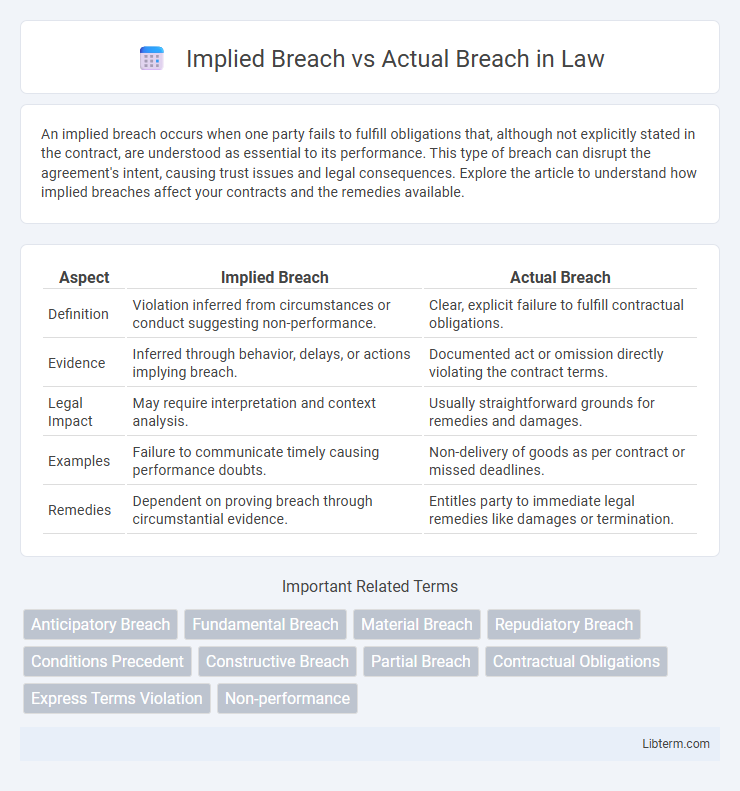An implied breach occurs when one party fails to fulfill obligations that, although not explicitly stated in the contract, are understood as essential to its performance. This type of breach can disrupt the agreement's intent, causing trust issues and legal consequences. Explore the article to understand how implied breaches affect your contracts and the remedies available.
Table of Comparison
| Aspect | Implied Breach | Actual Breach |
|---|---|---|
| Definition | Violation inferred from circumstances or conduct suggesting non-performance. | Clear, explicit failure to fulfill contractual obligations. |
| Evidence | Inferred through behavior, delays, or actions implying breach. | Documented act or omission directly violating the contract terms. |
| Legal Impact | May require interpretation and context analysis. | Usually straightforward grounds for remedies and damages. |
| Examples | Failure to communicate timely causing performance doubts. | Non-delivery of goods as per contract or missed deadlines. |
| Remedies | Dependent on proving breach through circumstantial evidence. | Entitles party to immediate legal remedies like damages or termination. |
Understanding Contract Breaches
Understanding contract breaches involves distinguishing between implied breach and actual breach, both critical in contract law. An implied breach occurs when a party's actions or omissions suggest a failure to perform contractual duties, without explicit refusal, often inferred from conduct or circumstances. An actual breach happens when one party explicitly fails to fulfill their contractual obligations, such as non-payment or non-delivery of goods, directly violating the contract terms.
Defining Implied Breach
Implied breach occurs when a party's actions or conduct indicate they will not fulfill contractual obligations, even without an explicit statement of non-performance. This form of breach is inferred from behavior that suggests intent or inability to perform, distinct from an actual breach where a clear failure to perform has already taken place. Understanding implied breach involves evaluating the circumstances and communications that foreseeably undermine contract completion.
What Constitutes an Actual Breach
An actual breach occurs when one party explicitly fails to perform a contractual duty by the specified time or delivers defective or incomplete performance, directly violating the contract terms. This breach is evidenced by clear actions or omissions, such as non-payment, failure to deliver goods, or refusal to fulfill agreements. Courts typically require demonstrable proof of these specific failures to substantiate an actual breach claim.
Key Differences Between Implied and Actual Breach
Implied breach occurs when a party's conduct indicates an intention not to perform contractual obligations, even if no explicit refusal is stated, while actual breach involves a clear failure to fulfill terms by a specific deadline. Key differences include the timing and nature of the breach: implied breach is anticipatory, arising before performance is due, whereas actual breach happens upon non-performance or defective performance at the time of fulfillment. Legal remedies vary as well, with implied breach allowing for immediate action to mitigate damages, while actual breach typically prompts claims after the deadline is missed or conditions are violated.
Common Examples of Implied Breach
Common examples of implied breach in contract law include failure to deliver goods by the agreed date, providing substandard or defective products, and not performing services with reasonable care or skill. Implied breaches often arise when a party's conduct indicates an unwillingness or inability to fulfill contractual obligations, such as consistently missing deadlines or failing to meet quality standards. Courts frequently interpret these actions as evidence that the contract terms, though not explicitly breached in writing, have been effectively violated through performance deficiencies.
Real-World Cases of Actual Breach
Real-world cases of actual breach often involve clear evidence of failure to perform contractual obligations, such as non-delivery of goods, missed deadlines, or substandard work. Courts rely on specific instances demonstrating the exact nature and extent of the breach, distinguishing it from implied breaches, which are inferred from conduct or circumstances without explicit violation. Notable cases like Hadley v. Baxendale underscore the significance of actual breach in determining damages and enforcing accountability under contract law.
Legal Consequences of Breach Types
Legal consequences of implied breach often involve damages that recognize failure to perform obligations presumed under contract terms, while actual breach triggers immediate rights to remedies including contract termination and specific performance claims. Courts may impose penalties or award compensatory damages depending on whether the breach was fundamental, with actual breaches typically leading to more decisive remedies. Understanding distinctions between these breach types informs contract enforcement and dispute resolution strategies within commercial law.
Proving Implied vs Actual Breach in Court
Proving an actual breach in court requires concrete evidence demonstrating a specific contractual term was violated, often through direct documentation or witness testimony. In contrast, establishing an implied breach hinges on interpreting conduct or circumstances that suggest a party failed to fulfill obligations, relying on inferred intent and the reasonable expectations of the parties involved. Courts analyze contract language, performance history, and industry standards to distinguish between explicit breaches and those implied by actions or omissions.
Preventing Breach in Contract Drafting
Preventing breaches in contract drafting hinges on clearly defining obligations and performance standards to distinguish between implied breach and actual breach. Incorporating specific clauses such as cure periods and detailed remedies helps address potential non-performance before it escalates to an actual breach. Emphasizing precise language and foreseeability in contract terms minimizes ambiguity, reducing the risk of disputes related to implied breaches.
Remedies Available for Implied and Actual Breach
Remedies available for an actual breach of contract typically include damages, specific performance, or contract termination depending on the nature and severity of the breach. In the case of an implied breach, where non-performance is inferred from conduct rather than explicit terms, remedies often focus on damages to compensate for losses due to the presumed failure. Courts analyze the contractual obligations' intent and circumstances to determine the appropriate remedy, emphasizing compensatory damages in implied breaches and broader equitable relief in actual breaches.
Implied Breach Infographic

 libterm.com
libterm.com